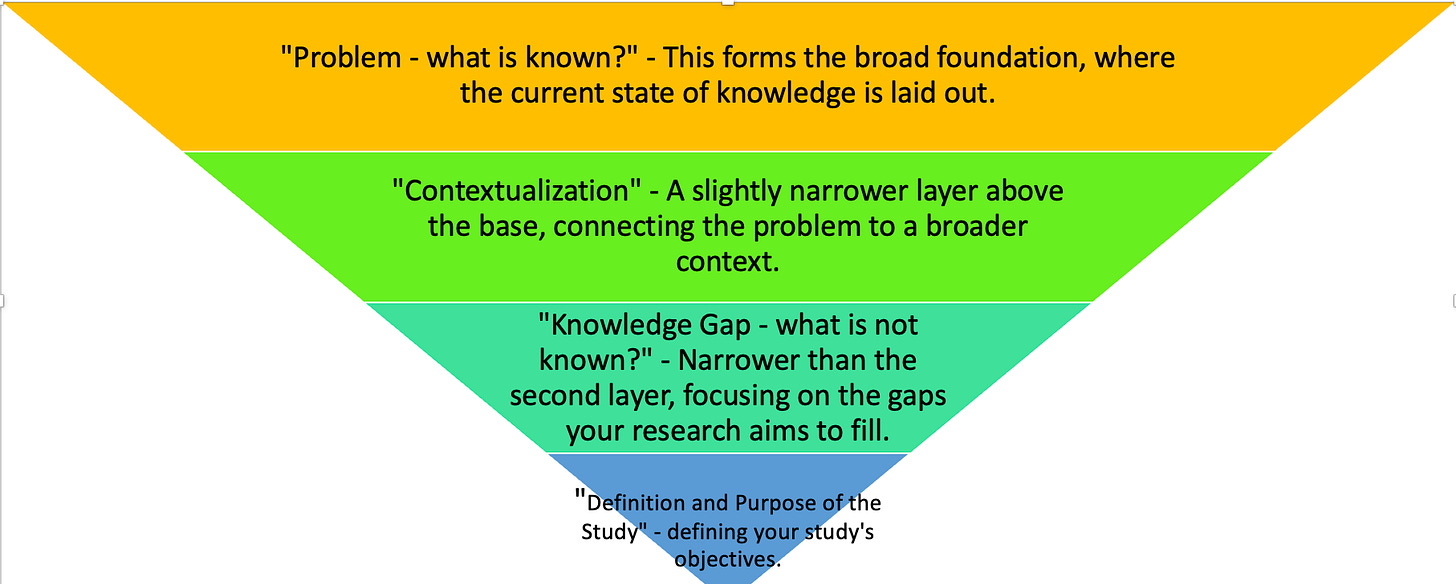How to Craft the Perfect Introduction for Your Scientific Paper: A Step-by-Step Guide
-With a nifty template
The introduction section is one of the most important parts of a scientific paper. It sets the stage for the entire paper and gives readers their first impression of your work. A well-written introduction quickly engages readers, establishes your credibility as a researcher, and convinces them that your study is worth reading about.
In this comprehensive guide, we provide science writers, researchers, and academics with a detailed walkthrough and template to follow how to write a compelling introduction that will wow journal editors and readers.
Why the Introduction Matters in Scientific Writing
The introduction is the first thing editors, reviewers, and readers will see when assessing your scientific paper. It acts as a gateway into the rest of your work.
Here are four key reasons why nailing your introduction is critical:
1. Creates a First Impression
The introduction is your chance to make a strong first impression. A vague, disorganized, or dull introduction sets off alarm bells and makes readers unsure about the quality of your research.
Crafting a crisp, engaging opening section shows editors and readers that you can communicate science effectively. It quickly convinces them your study is well-designed and your findings are significant.
2. Establishes Your Credibility
How you write your introduction establishes your scientific credibility and qualifications. It demonstrates your ability to synthesize large amounts of complex information and hone in on the most salient points.
When you showcase knowledge of the field and properly cite authoritative sources, you come across as an expert. This earns you the trust of editors, reviewers, and readers right from the start.
3. Contextualizes Your Research
A good introduction doesn't just describe your study; it contextualizes it. By summarizing current understanding and identifying knowledge gaps, you frame your research within the larger scientific field.
This context convinces readers that your work is relevant timely, and advances the field meaningfully. It helps establish the significance of your study.
4. Acts as a Roadmap
Finally, the introduction acts as a roadmap for the paper itself. A well-structured overview not only tells readers what to expect but helps guide them smoothly through the entirety of your work.
With a solid introduction as their guide, readers are primed to understand the key arguments and takeaways of your research.
Structure of an Effective Introduction
Introductions answer two questions: what is the gap of knowledge needed for this study, and how does this study fill that gap? The paper is a story that starts in the intro and ends in the discussion. In that way, the introduction is the. To phrase it differently, it needs to identify a knowledge gap, explain why this gap needs filling, and show how this study fills that gap.
According to a study analyzing all papers in the jacc cardiology journal in 2013. Here is the breakdown of the length of each part of the paper according to their findings. Introductions are very compact and generally only 11% of the paper, or 1 page (ideally), maximum 400 words over 1-4 paragraphs (ideally 3) - some journals restrict this to 350 words (E.g., ABC); 5-10 references(Araújo, 2014).
Scientific introductions generally follow a standard structure consisting of four key elements. Let's look at each in detail:
Opening
Starts with a broad opening statement on the research field
Sets the overall scene and scope
Background
Review previous work and current understanding of the topic
Summarizes relevant foundational/seminal research
Provides context for readers
Gap
Identifies limitations, contradictions, and gaps in existing research
States why certain key problems remain unsolved or underexplored
Highlight explicitly what your study aims to address
Study Overview
Outline the purpose, focus, and nature of your investigation
States research questions, hypotheses, and objectives
Briefly explain the methodology and approach
This basic framework allows you to establish relevance, orient readers, carve a niche for your work, and map out the ensuing paper. Let's see how to execute each section successfully.
Opening Section
The opening paragraph is crucial for grabbing the reader's attention right away. Avoid vague, general statements here. Be as specific as possible when introducing the broad research field.
For example:
Weak opening: "Cancer research is very important today."
Strong opening: "Lung cancer remains the leading cause of cancer deaths worldwide, responsible for over 1.7 million fatalities annually."
When drafting your opening:
Hook readers with an interesting fact/stat or thought-provoking question
Briefly explain why this field is significant, timely, or relevant
Keep it focused and specific to set the scope of the paper
Cite a reputable source if presenting a statistic or claim
This section should be concise - 1-2 paragraphs at most. It sets the stage for the background review.
Background Section
The background review summarizes existing work on your research topic to contextualize your study. It demonstrates your command of the field.
When conducting the literature review:
Include 5-8 of the most important papers or findings
Cover seminal/foundational research as well as recent studies
Organize chronologically or thematically as fits your narrative
Analyze; don't just summarize each paper separately
Synthesize; identify overarching trends/themes across papers
This section comprises the bulk of the introduction. Take 2-3 paragraphs to cover early work, then 3-4 paragraphs to discuss recent developments and the current state of the field.
Identifying the Gap
With the background established, the next task is identifying critical knowledge gaps. You need to convince readers that there is a compelling problem that your study addresses.
Common approaches include:
Pinpointing gaps in the literature
Revealing limitations of previous work
Identifying contradictions among existing findings
Explaining how certain research questions remain unanswered
Describing how practical problems remain unsolved
Phrase this section carefully. Avoid overly criticizing other researchers. Frame the gap as an opportunity for advancement rather than a flaw in current work.
This part is generally 1 paragraph explicitly setting up the need for and timeliness of your investigation.
Overview of Your Study
With the need established, clearly define the purpose and nature of your research.
Include:
Research aims, objectives, and questions
Specific hypotheses being tested, if applicable
Brief description of study methodology and design
Scope and limitations of your investigation
Avoid going into excessive detail or discussing actual findings here. The goal is to provide a broad preview and framing of your study, not give away results.
Keep this section to 1-2 concise paragraphs. You will expand on methods/results in subsequent sections.
Let's look at a sample introduction integrating these elements:
Common Pitfalls to Avoid
While introductions seem straightforward, many writers make mistakes that weaken their impact and credibility. Here are key pitfalls to avoid:
Don't Open with Broad, Vague Statements
Intro sentences like "Cancer is a major problem worldwide" are dull, offer no specific context and don't engage readers. Open with a compelling fact or statistic instead.
Don't Make Sweeping Claims
Avoid overstating the novelty or impact of your work. Stick to measured statements supported by citations. Let the study speak for itself.
Don't Go into Excessive Detail
Don't devote paragraphs to minor tangents or literature that isn't directly relevant. Stick to seminal and recent studies that set up your research.
Don't Just Summarize Previous Papers
The background shouldn't just be a series of summary paragraphs of past papers. Synthesize across papers to identify overarching themes/trends.
Don't Be Vague About the Gap
Explicitly state the specific gaps, limitations, contradictions, or unanswered questions you aim to address. Avoid vague statements about the need for more research.
Don't Use Overly Critical Language
Critiquing previous work is an important part of identifying gaps. However, avoid language that comes across as overly disparaging to other researchers.
Helpful Tips for Writing a Strong Introduction
Follow these tips to craft an introduction that hooks readers, establishes context, and clearly sets up the rationale for your study:
Spend time organizing your literature into a logical narrative flow before drafting.
Focus on landmark studies and recent developments; cite 5-8 key papers.
Synthesize; don't just summarize one paper at a time.
Be explicit in identifying gaps; say "however..." or "in contrast..."
Phrase the gap as an opportunity to advance understanding.
Keep background concise; aim for 400 words over 3-4 paragraphs.
Avoid technical terms/jargon unless absolutely necessary.
Be clear and specific when stating research aims and questions.
Ask a colleague to review your draft and provide feedback.
Introduction template and guide
Problem - What is Known?
Start with a broad opening sentence that sets the stage for the research area.
Briefly summarize the current state of knowledge in your field.
Use this section to introduce the general topic and its significance.
Example: "The field of [Your Research Area] has significantly expanded in the last decade, with notable advancements in [Specific Aspects]. Despite these developments, several critical areas remain unexplored."
Contextualization
Connect the identified problem to its broader implications.
Explain why this problem is important to your field or the wider world.
Address how this problem impacts relevant stakeholders or society.
Example: "Understanding [Specific Aspect] is crucial for [Reason], affecting [Stakeholders/Society] by [Implications]. This underscores the need for further research in this area."
Knowledge Gap - What is Not Known?
Identify and articulate the gaps in the existing literature or knowledge.
Highlight what is missing from the current understanding.
Use this to bridge what your research specifically addresses.
Example: "However, existing research lacks comprehensive insights into [Specific Aspect], particularly in the context of [Specific Context]. This gap in knowledge hinders our understanding of [Implications of the Gap]."
Definition and Purpose of the Study
Clearly state the purpose of your study.
Define the scope and objectives of your research.
Introduce your research question or hypothesis.
Example: "This study aims to address this gap by [Your Study's Aim]. Through [Methods/Approach], the research will explore [Specific Elements], thereby contributing to [Field/Understanding]."
Note: This introduction should ideally be contained within 1 page, not exceeding 400 words, ideally structured into three paragraphs, and supported by 5-10 references.
Concluding thoughts
The introduction serves a vital purpose in scientific writing. Crafting a compelling opening section requires brevity, organization, and clarity. Following the standard structure, along with the best practices discussed above, will help you write introductions that impress editors, engage readers, and enhance the impact of your published papers. Remember to start broad, review previous literature, highlight gaps, and clearly frame your study. Let us know in the comments if this guide helps you improve your scientific introductions moving forward!
References
Araújo C. G. (2014). Detailing the writing of scientific manuscripts: 25-30 paragraphs. Arquivos brasileiros de cardiologia, 102(2), e21–e23. https://doi.org/10.5935/abc.20140019







